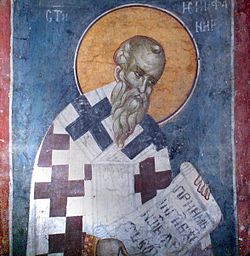Epifani wa Salamina
Mandhari
(Elekezwa kutoka Epiphanius of Salamis)

Epifani wa Salamina (kwa Kigiriki: Ἐπιφάνιος; Besanduk, karibu na Eleutheropolis, leo Beit Guvrin, Israeli [1]310–320 hivi – 403) alikuwa mmonaki nchini Misri, halafu askofu wa Salamina, Kupro, maarufu kwa juhudi za kutetea imani sahihi ya Kanisa Katoliki[2].
Mwenye elimu kubwa na ujuzi wa maandiko ya Kikristo, msemaji wa lugha tano tofauti[3], anajulikana hasa kwa kitabu chake Panarion alichokitunga miaka 374-377 kwa ajili ya kupinga aina 80 za uzushi zilizoenea kati ya Wakristo[4].
Pamoja na hayo, aling'aa pia kwa maisha matakatifu, ukarimu kwa maskini na karama ya kufanya miujiza.
Tangu kale anaheshimiwa na Wakatoliki na Waorthodoksi kama mtakatifu na Baba wa Kanisa.
Sikukuu yake huadhimishwa tarehe 12 Mei[5][6].
Maandishi
[hariri | hariri chanzo]- The Panarion of Epiphanius of Salamis, Book I (Sects 1–46) Frank Williams, translator, 1987 (E.J. Brill, Leiden) ISBN 90-04-07926-2
- The Panarion of Epiphanius of Salamis, Book II and III (Sects 47–80, De Fide) Frank Williams, translator, 1993 (E.J. Brill, Leiden) ISBN 90-04-09898-4
- The Panarion of St. Epiphanius, Bishop of Salamis Philip R. Amidon, translator, 1990 (Oxford University Press, New York) (This translation contains selections rather than the full work.) ISBN 0-19-506291-4
- Epiphanius' Treatise on Weights and Measures: The Syriac Version, James Elmer Dean, ed, 1935. (Chicago) [English translation of On Weights and Measures; available at http://www.tertullian.org/fathers/epiphanius_weights_03_text.htm]
- Epiphanius de Gemmis: the Old Georgian Version and the Fragments of the Armenian Version. ed. Robert Pierpont Blake; de Vis, H. (1934). London: Christophers.
- Epiphanius von Salamis, Über die zwölf Steine im hohepriesterlichen Brustschild (De duodecim gemmis rationalis). Nach dem Codex Vaticanus Borgianus Armenus 31 herausgegeben und übersetzt by Felix Albrecht and Arthur Manukyan (Gorgias Eastern Christian Studies 37), 2014 (Gorgias Press: Piscataway) ISBN 978-1-4632-0279-8 (German edition).
Tazama pia
[hariri | hariri chanzo]- Watakatifu wa Agano la Kale
- Orodha ya Watakatifu Wakristo
- Orodha ya Watakatifu wa Afrika
- Orodha ya Watakatifu Wafransisko
- Mababu wa Kanisa
- Mababu wa jangwani
Tanbihi
[hariri | hariri chanzo]- ↑ The Panarion of Epiphanius of Salamis: Book I (Sects 1–46), By Epiphanius, Epiphanius of Salamis, Translated by Frank Williams, 1987 ISBN 90-04-07926-2 p xi
- ↑ Andrew Louth, 'Palestine', in Frances Young, Lewis Ayres and Andrew Young, eds, The Cambridge History of Early Christian Literature, (2010), p286
- ↑ including Hebrew, Syriac, Egyptian, Greek, and Latin, and was called by Jerome on that account Pentaglossos ("Five tongued"). Ruf 3.6
- ↑ His earliest known work is the Ancoratus (the well anchored man), which includes arguments against Arianism and the teachings of Origen. Aside from the polemics by which he is known, Epiphanius wrote a work of biblical antiquarianism, called, for one of its sections, On Weights and Measures (περὶ μέτρων καὶ στάθμων). It was composed in Constantinople for a Persian priest, in 392, and survives in Syriac, Armenian, and Georgian translations (this last is found in Shatberd ms 1141 along with Physiologus and De Gemmis). The first section discusses the canon of the Old Testament and its versions, the second of measures and weights, and the third, the geography of Palestine. The texts appear not to have been given a polish but consist of rough notes and sketches, as Allen A. Shaw, a modern commentator, concluded; nevertheless Epiphanius' work on metrology was important in the history of measurement. Another work, On the Twelve Gems (De Gemmis), survives in a number of fragments, the most complete of which is the Georgian. The letter written by Epiphanius to John, Bishop of Jerusalem, in 394 and preserved in Jerome's translation, is discussed above. The collection of homilies traditionally ascribed to a "Saint Epiphanius, bishop" are dated in the late fifth or sixth century and are not connected with Epiphanius of Salamis by modern scholars. Such was Epiphanius's reputation for learning that the Physiologus, the principal source of medieval bestiaries, came to be widely falsely attributed to him.
- ↑ Martyrologium Romanum
- ↑ Ὁ Ἅγιος Ἐπιφάνιος Ἐπίσκοπος Κωνσταντίας καὶ Ἀρχιεπίσκοπος Κύπρου. 12 Μαΐου. ΜΕΓΑΣ ΣΥΝΑΞΑΡΙΣΤΗΣ.
Marejeo
[hariri | hariri chanzo]- Kitzinger, Ernst, "The Cult of Images in the Age before Iconoclasm", Dumbarton Oaks Papers, Vol. 8, (1954), pp. 83–150, Dumbarton Oaks, Trustees for Harvard University, JSTOR
- Kim, Young Richard. Epiphanius of Cyprus: Imagining an Orthodox World. Ann Arbor: University of Michigan Press, 2015.
- Jacobs, Andrew S. Epiphanius of Cyprus: A Cultural Biography of Late Antiquity. Christianity in Late Antiquity. Oakland: University of California Press, 2016.
Viungo vya nje
[hariri | hariri chanzo]
Wikiquote ina mkusanyiko wa dondoo kuhusu:
- St Epiphanius of Salamis Orthodox Icon and Synaxarion
- "Epiphanius of Salamis". Catholic Encyclopedia. New York: Robert Appleton Company. 1913. http://www.newadvent.org/cathen/13393b.htm.
- Epiphanius, On Biblical Weights and Measures English translation of a Syriac text
- Some excerpts from the Panarion
- (The Panarion of Epiphanius of Salamis Book I Sects 1-46)
- Letter from Epiphianus, Bishop of Salamis, in Cyprus, to John, Bishop of Jerusalem
- Opera Omnia by Migne Patrologia Graeca with analytical indexes
- Stephen Craft Goranson, The Joseph of Tiberias Episode in Epiphanius: Studies in Jewish and Christian Relations (1990)
| Makala hii bado ni mbegu. Je, unajua kitu kuhusu Mkristo huyu, kama wasifu wake, habari za maisha au kazi yake? Je, unaona habari katika Wikipedia ya Kiingereza au lugha nyingine zinazofaa kutafsiriwa? Basi unaweza kuisaidia Wikipedia kwa kuihariri na kuiongezea habari. |
